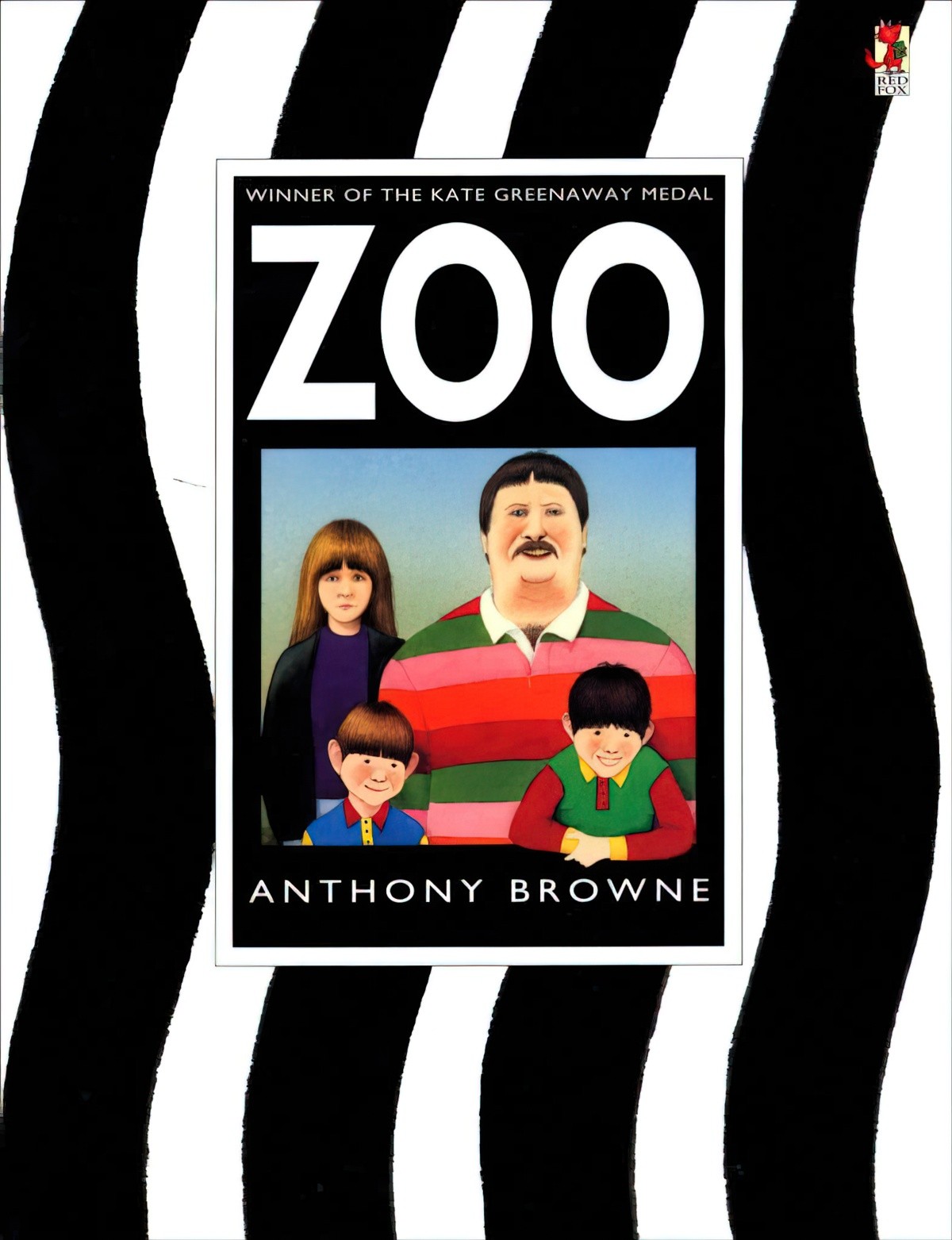Zoo is a postmodern picture book written and illustrated by Anthony Browne, first published in 1992. Browne’s story is not a pleasant or easy read, but it does the job it’s meant to. This is a critique of zoos as a fun day out (for children and animals alike), and subverts a long tradition in children’s literature as zoos as an arena for carnivalesque fun.
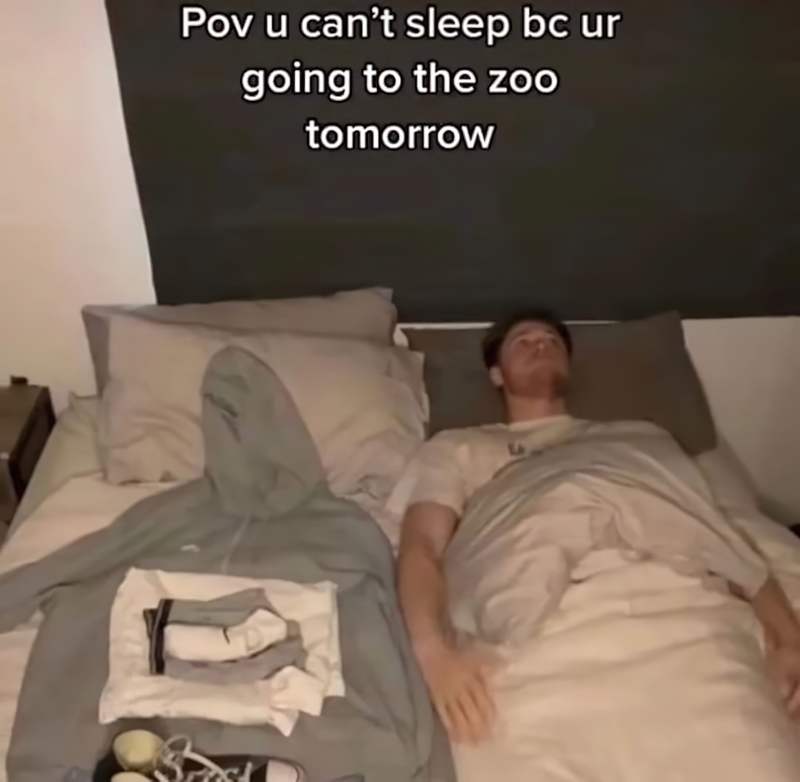
20th century children’s books set in zoos are not hard to find. Zoos also appear frequently in art aimed at an adult audience:
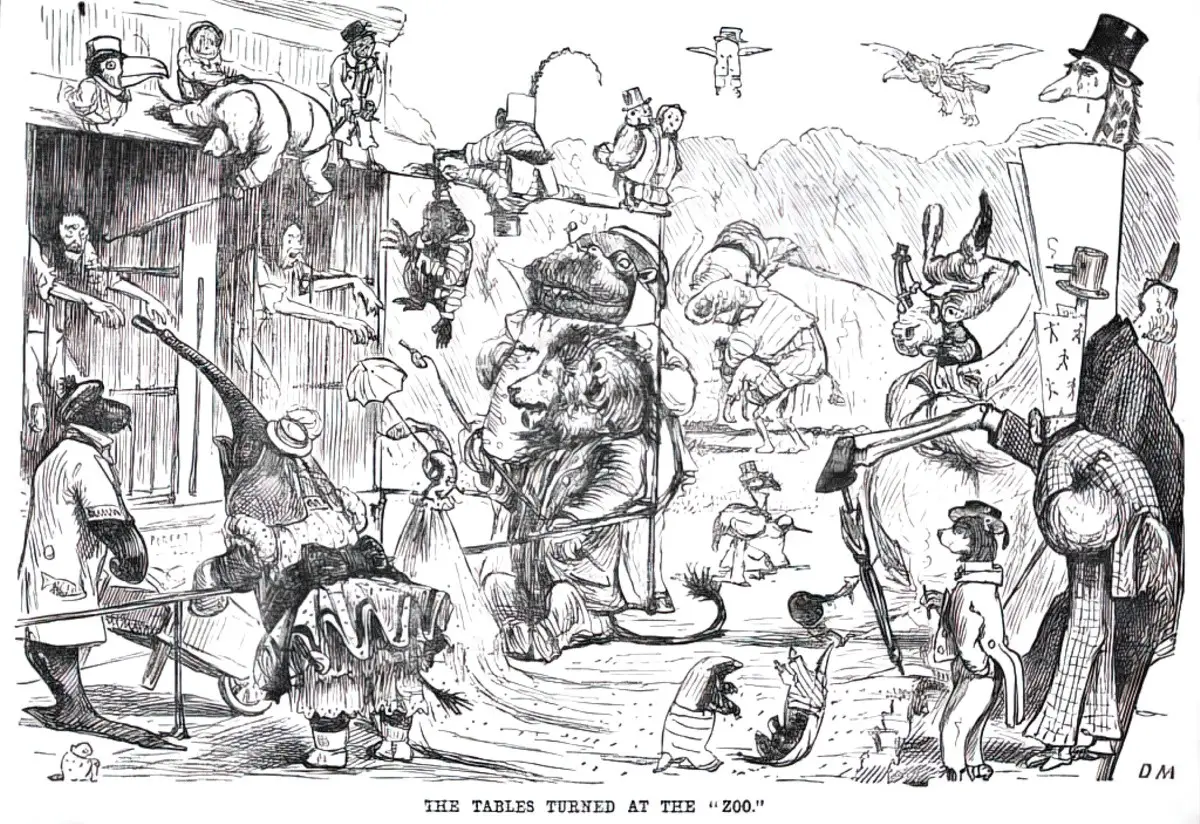
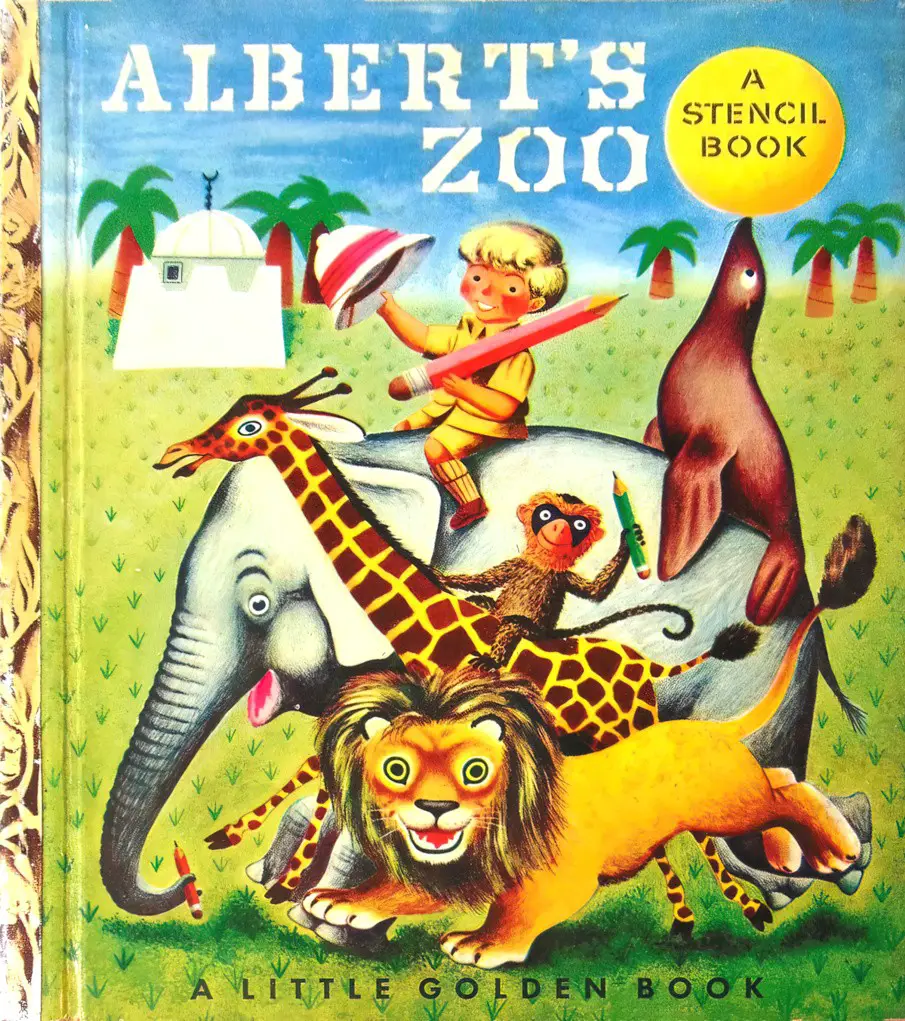
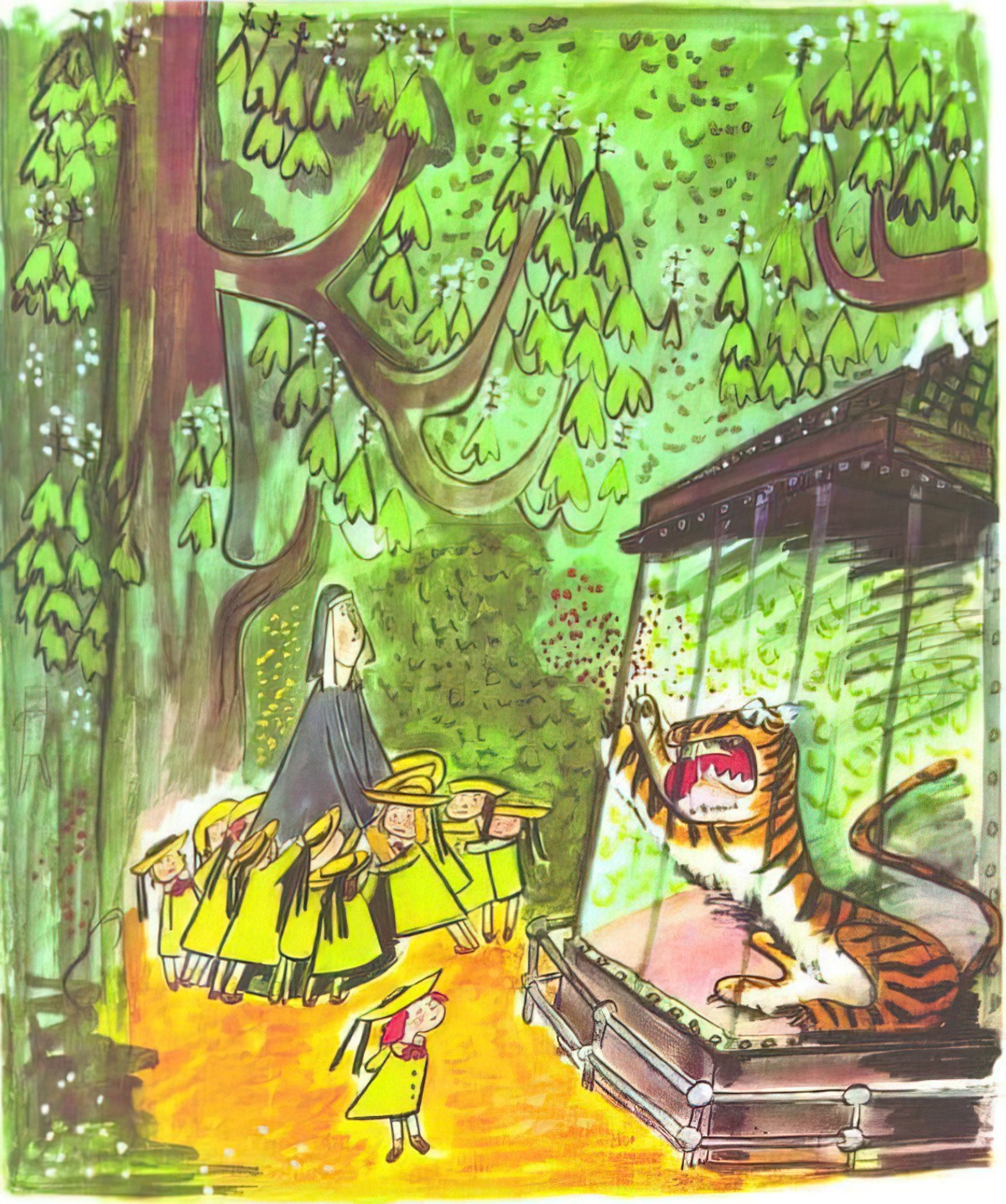
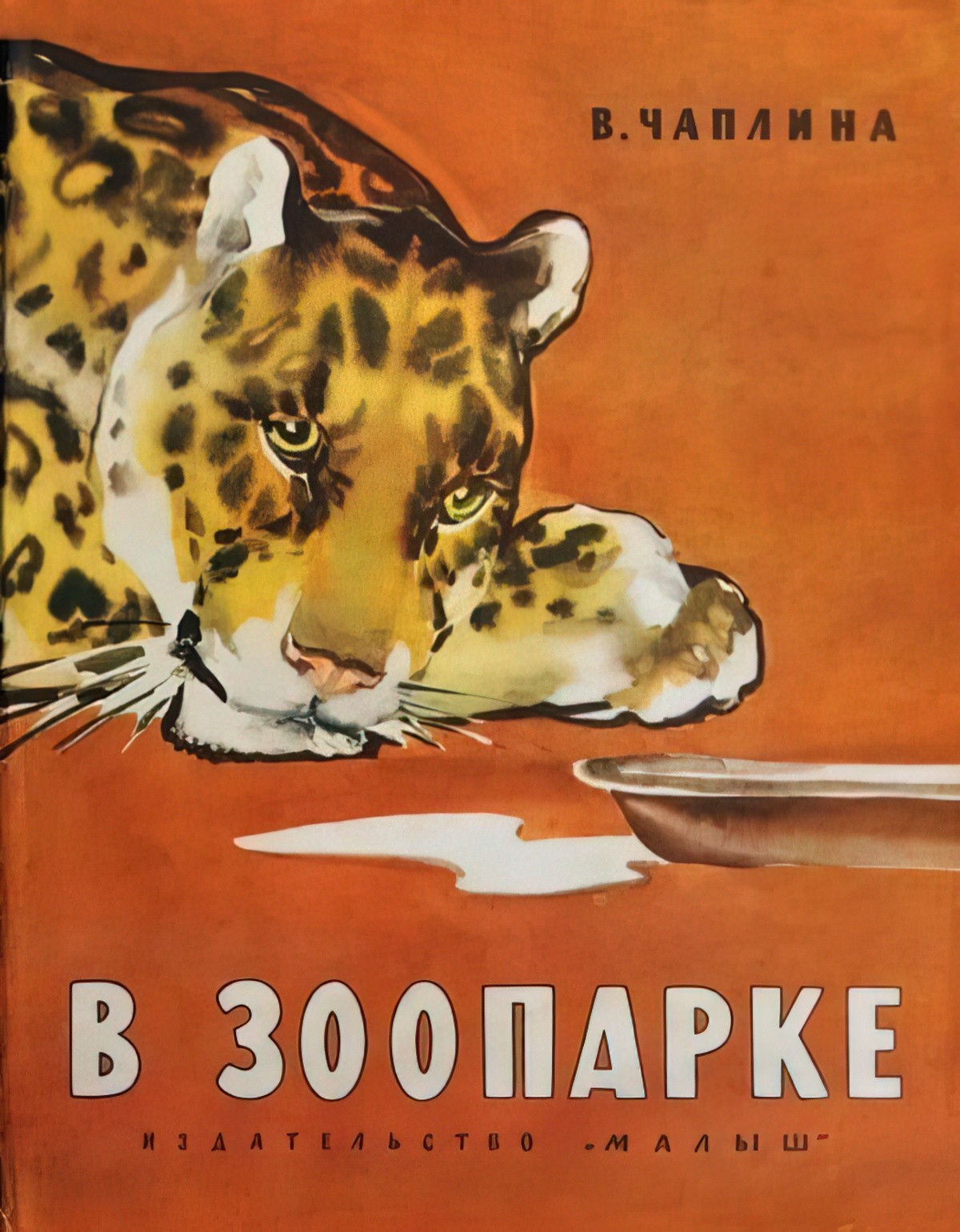
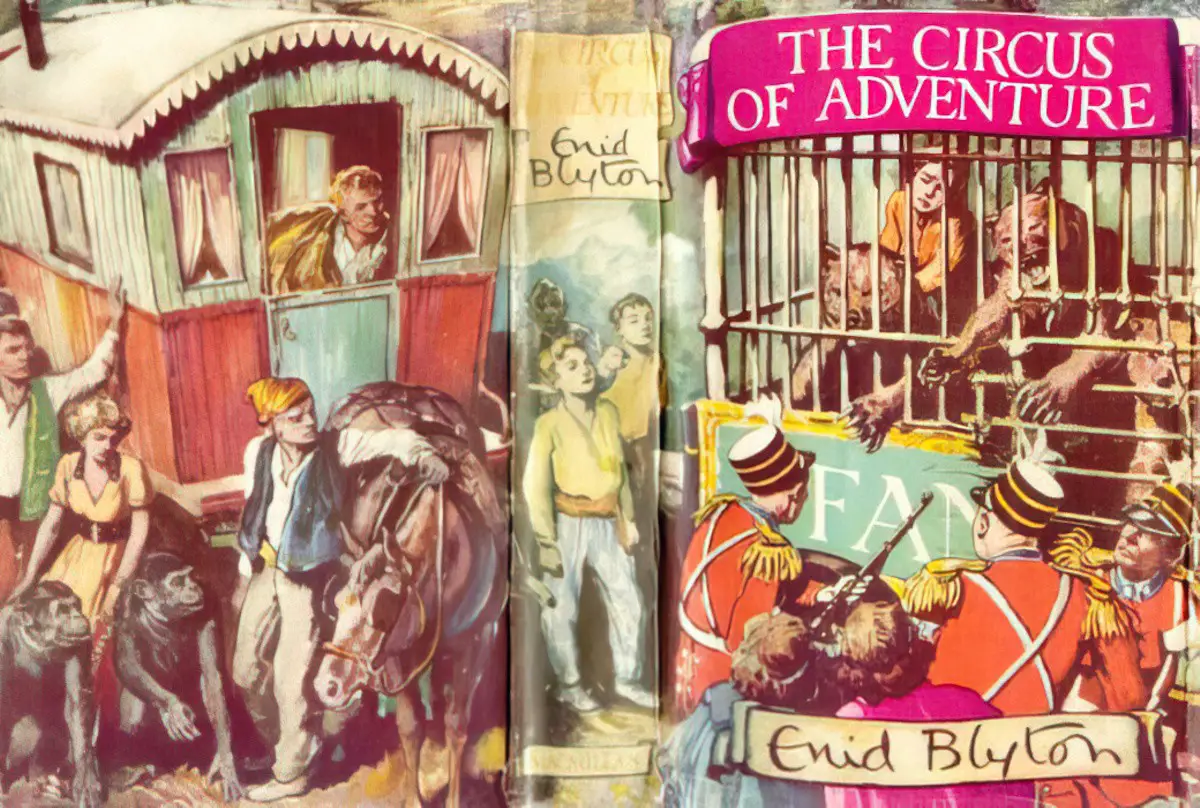
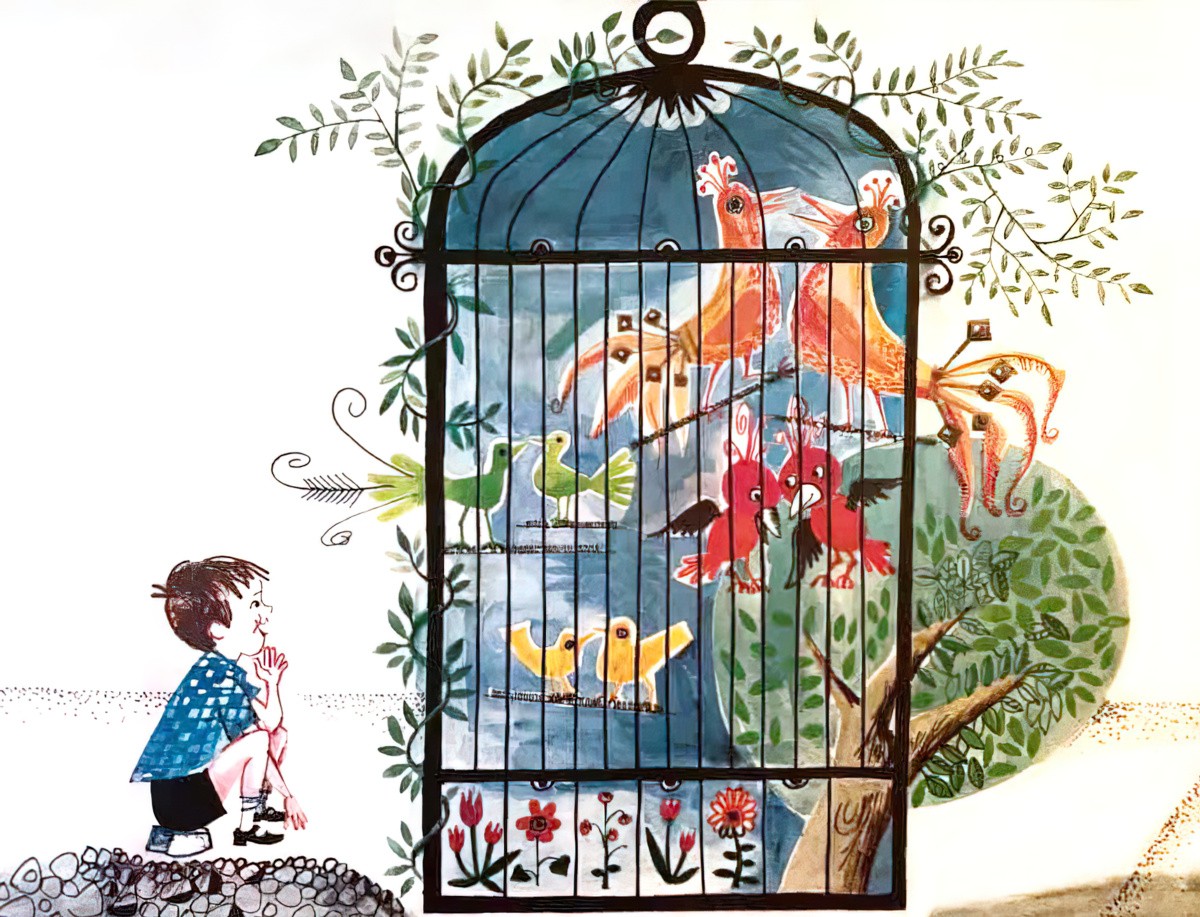
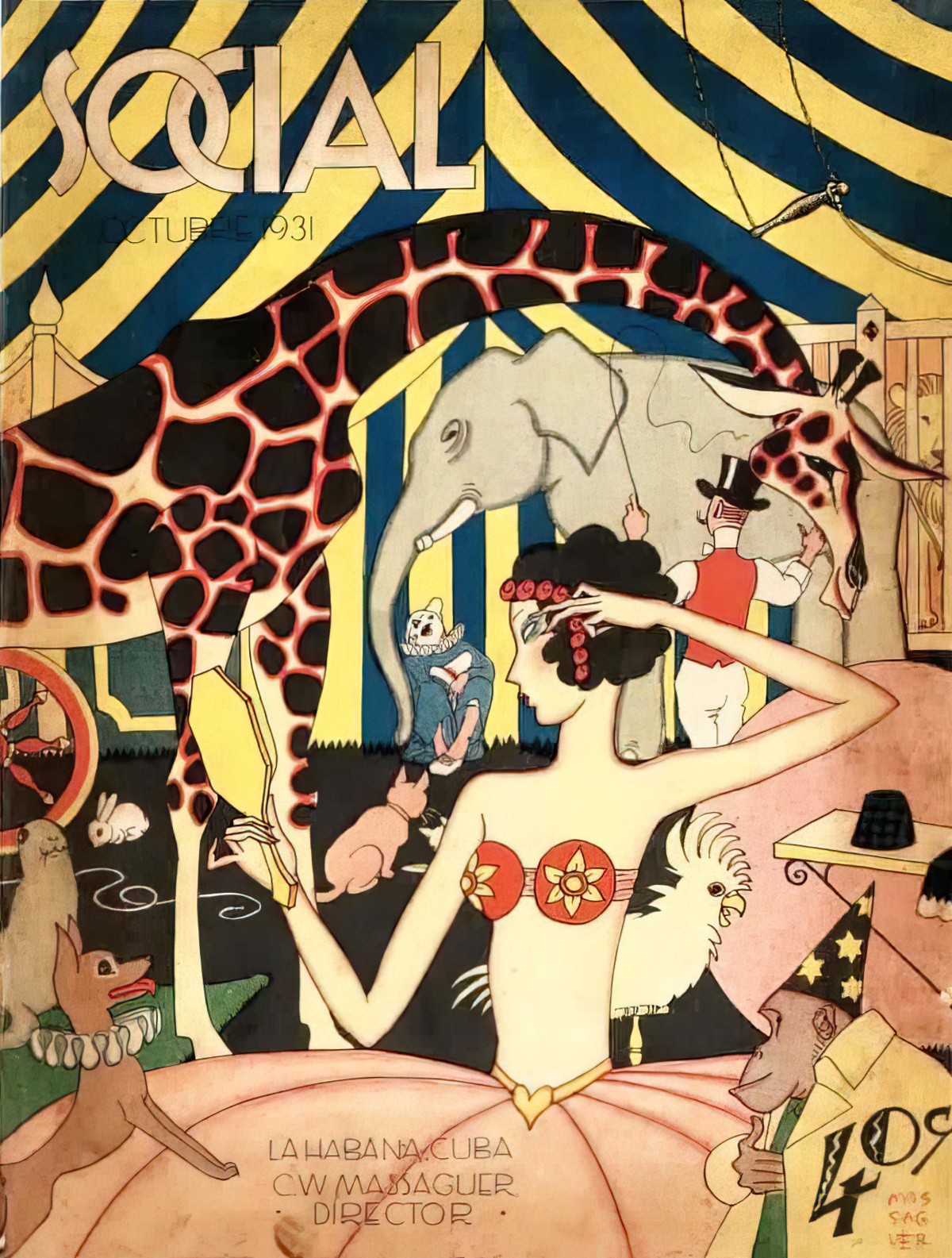
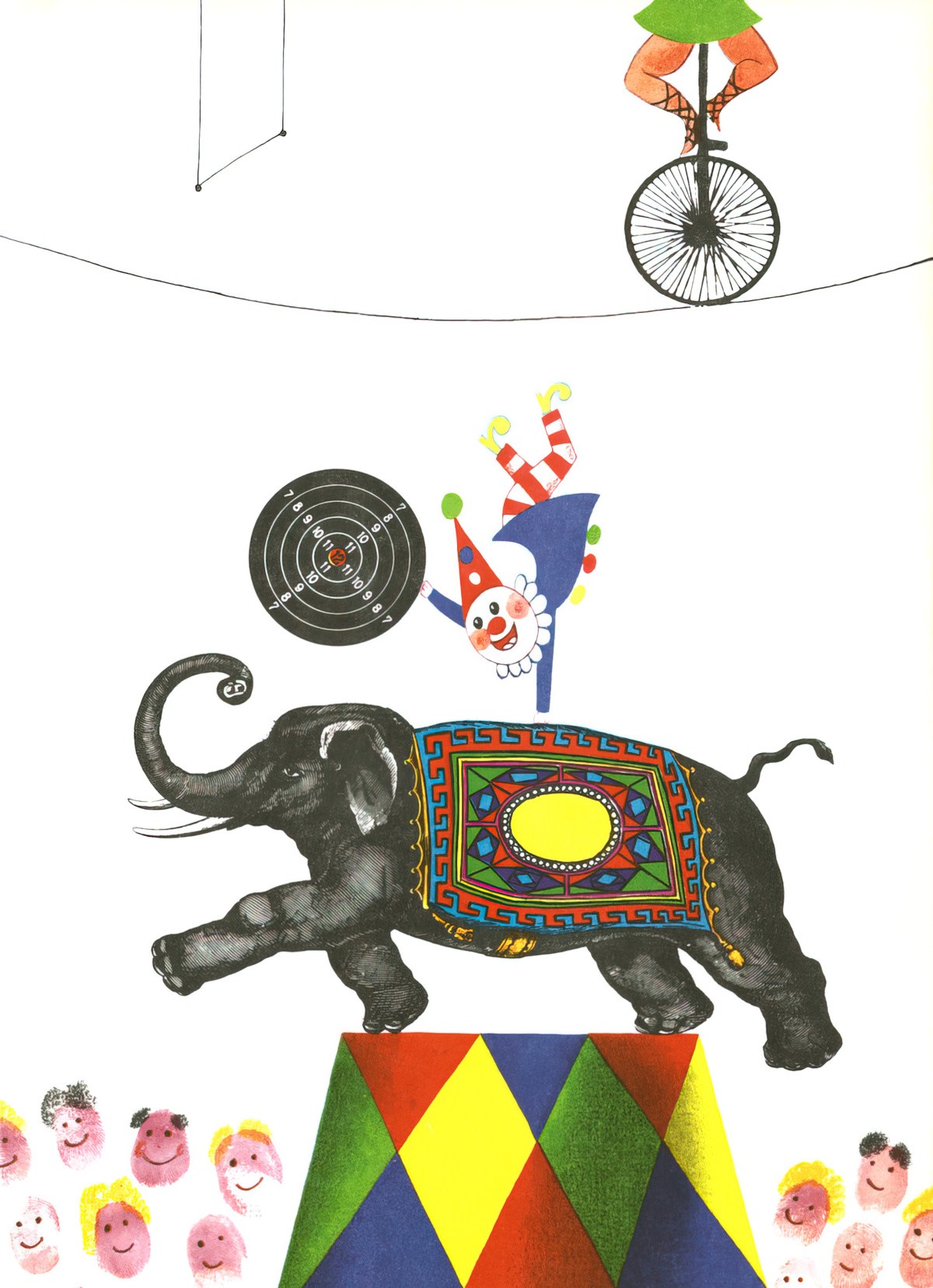
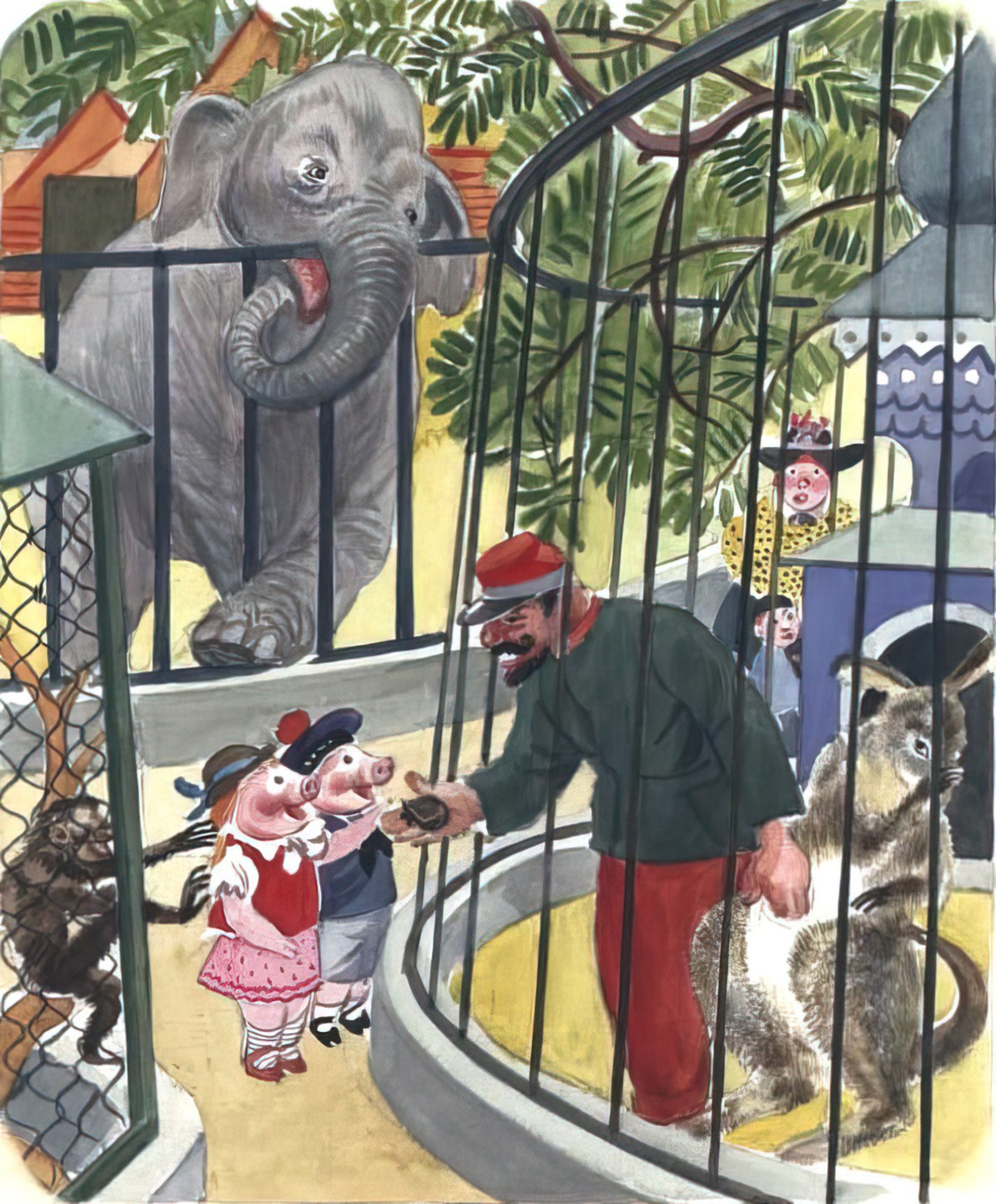
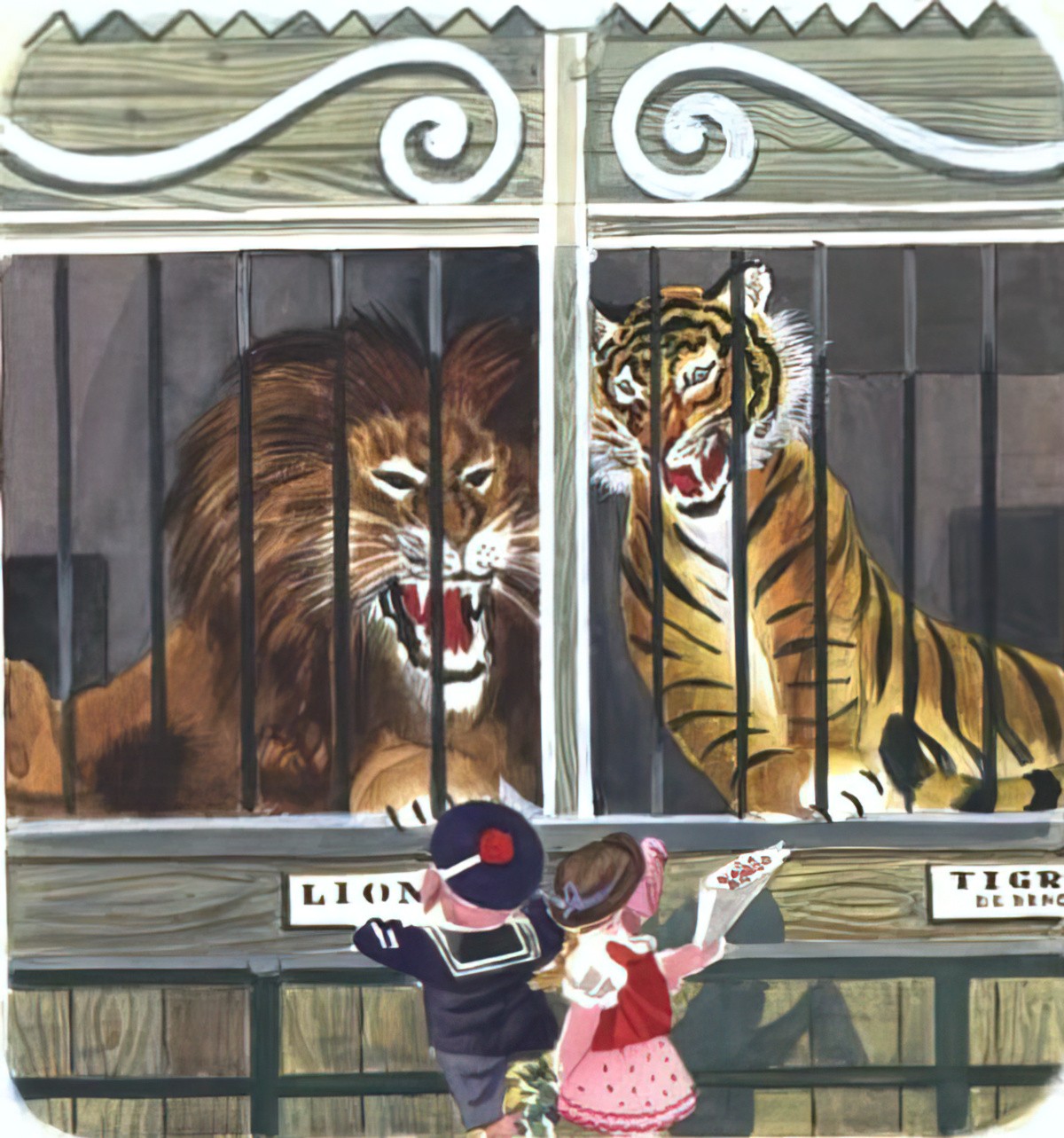
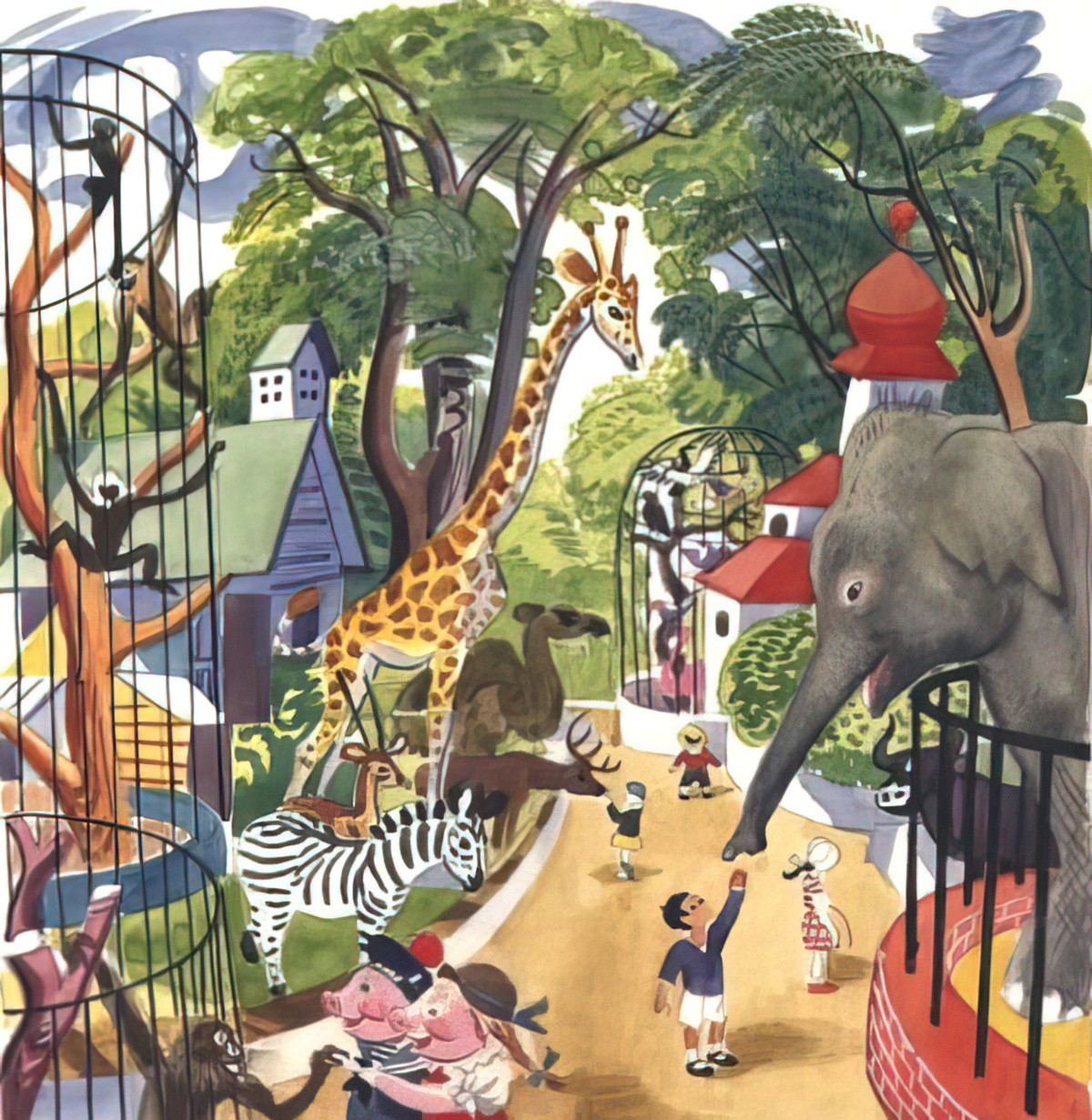
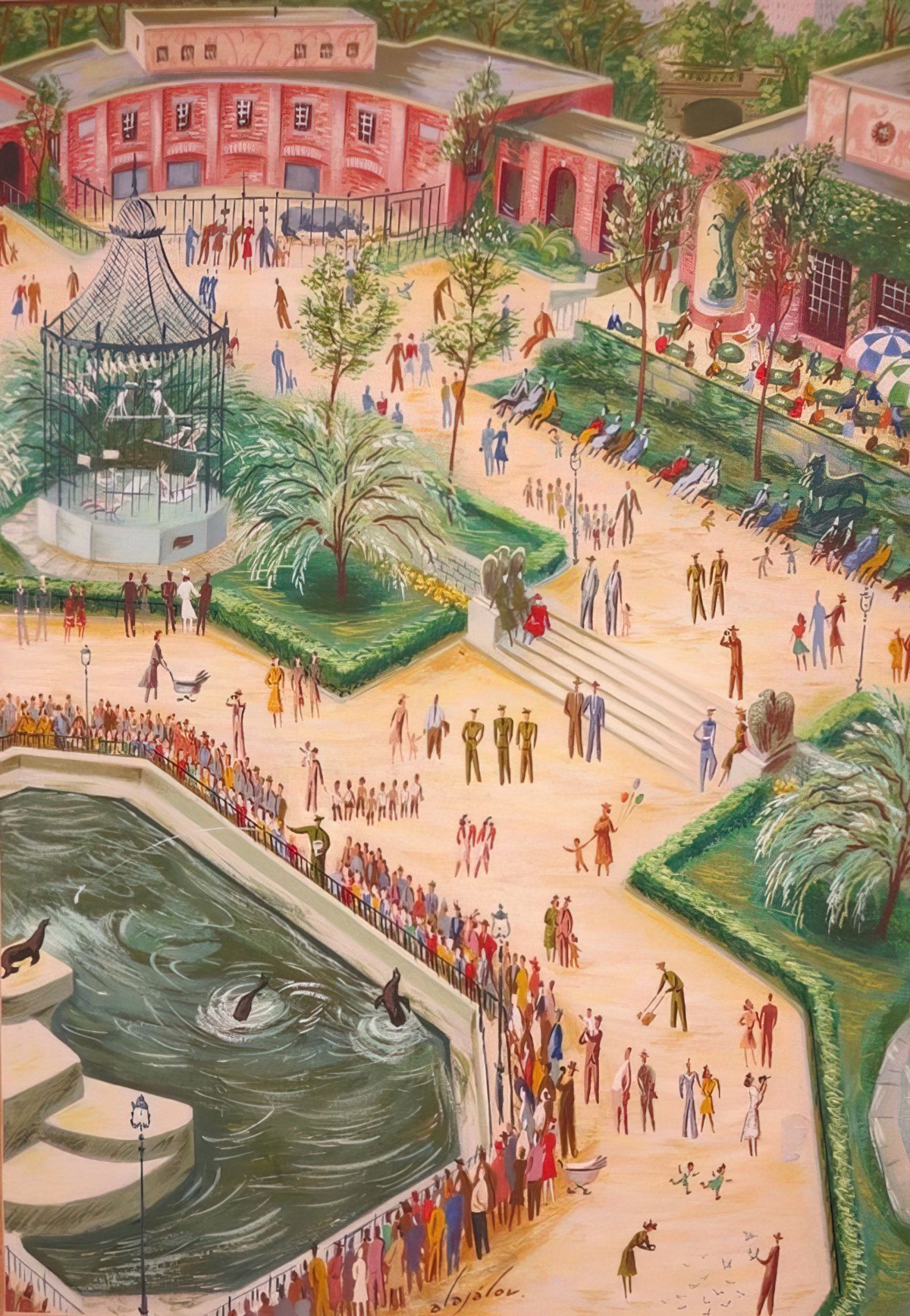
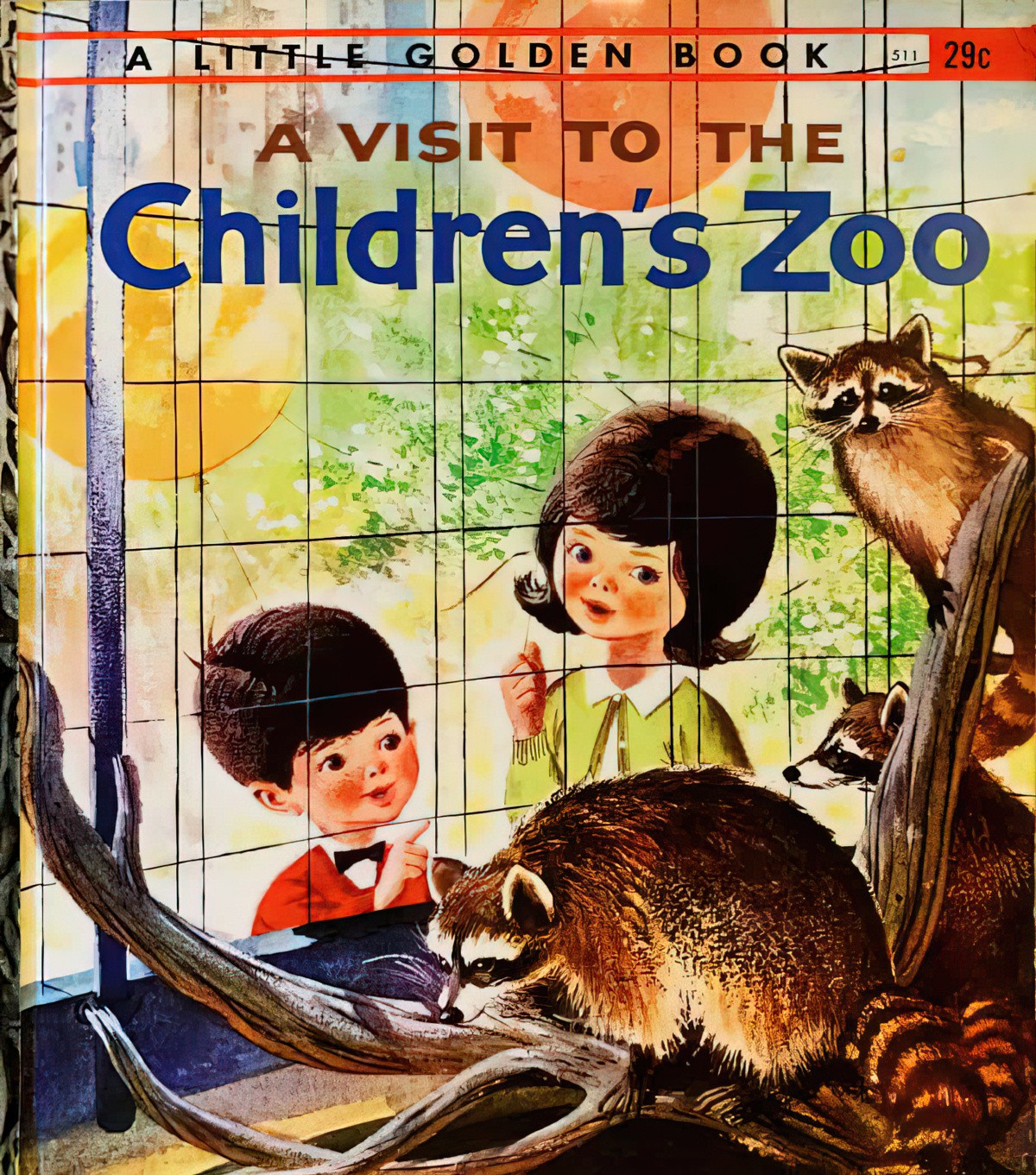
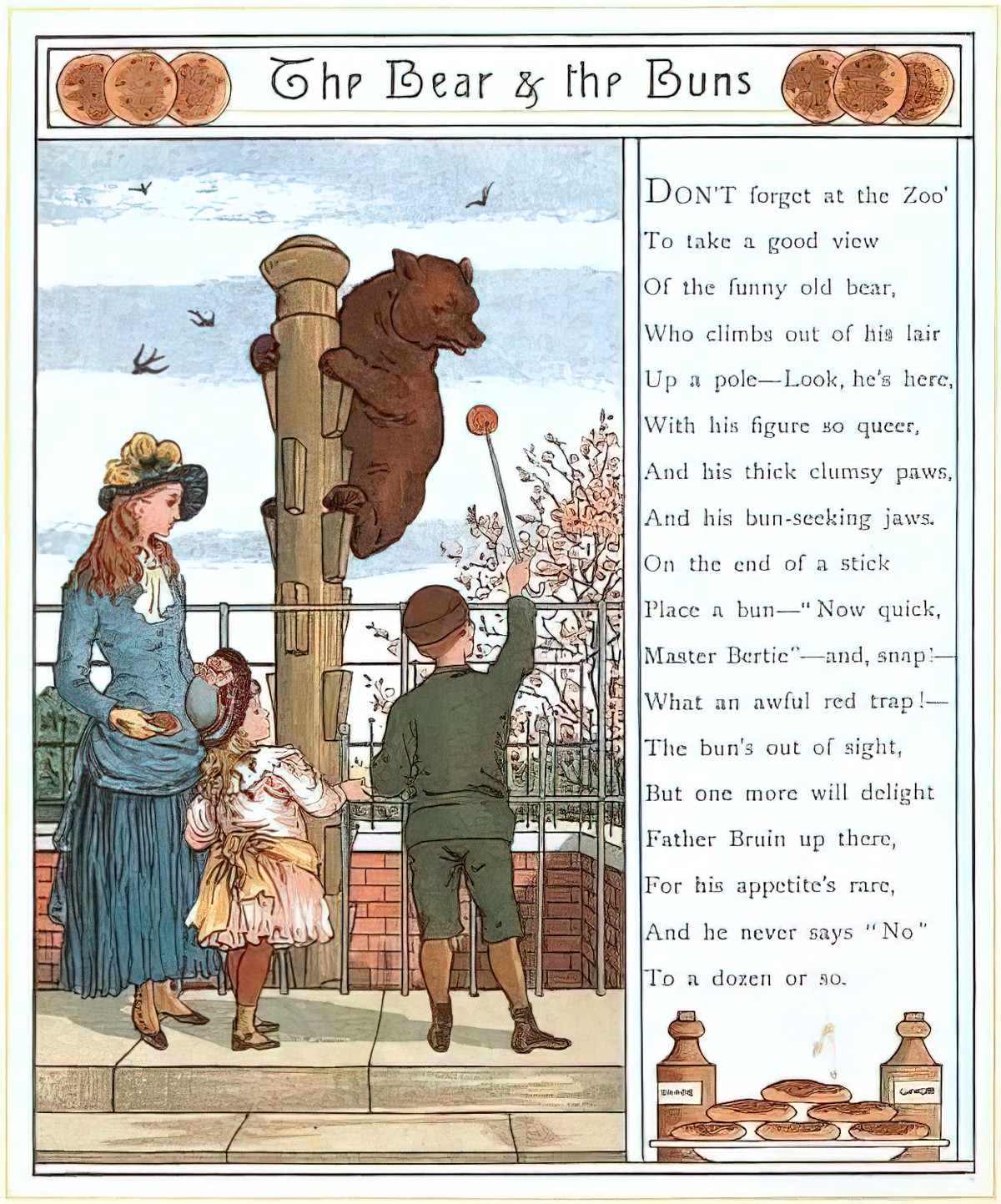
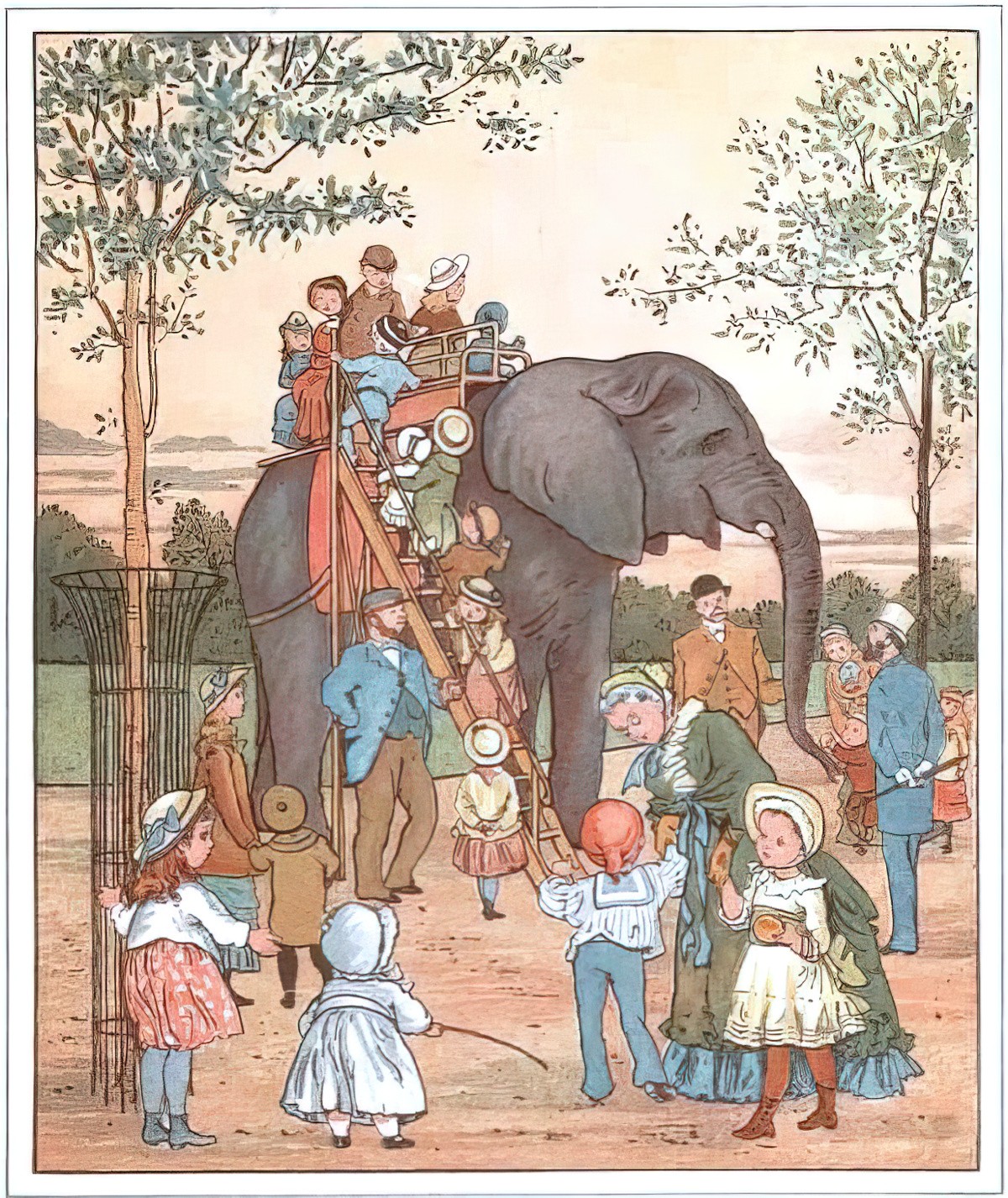
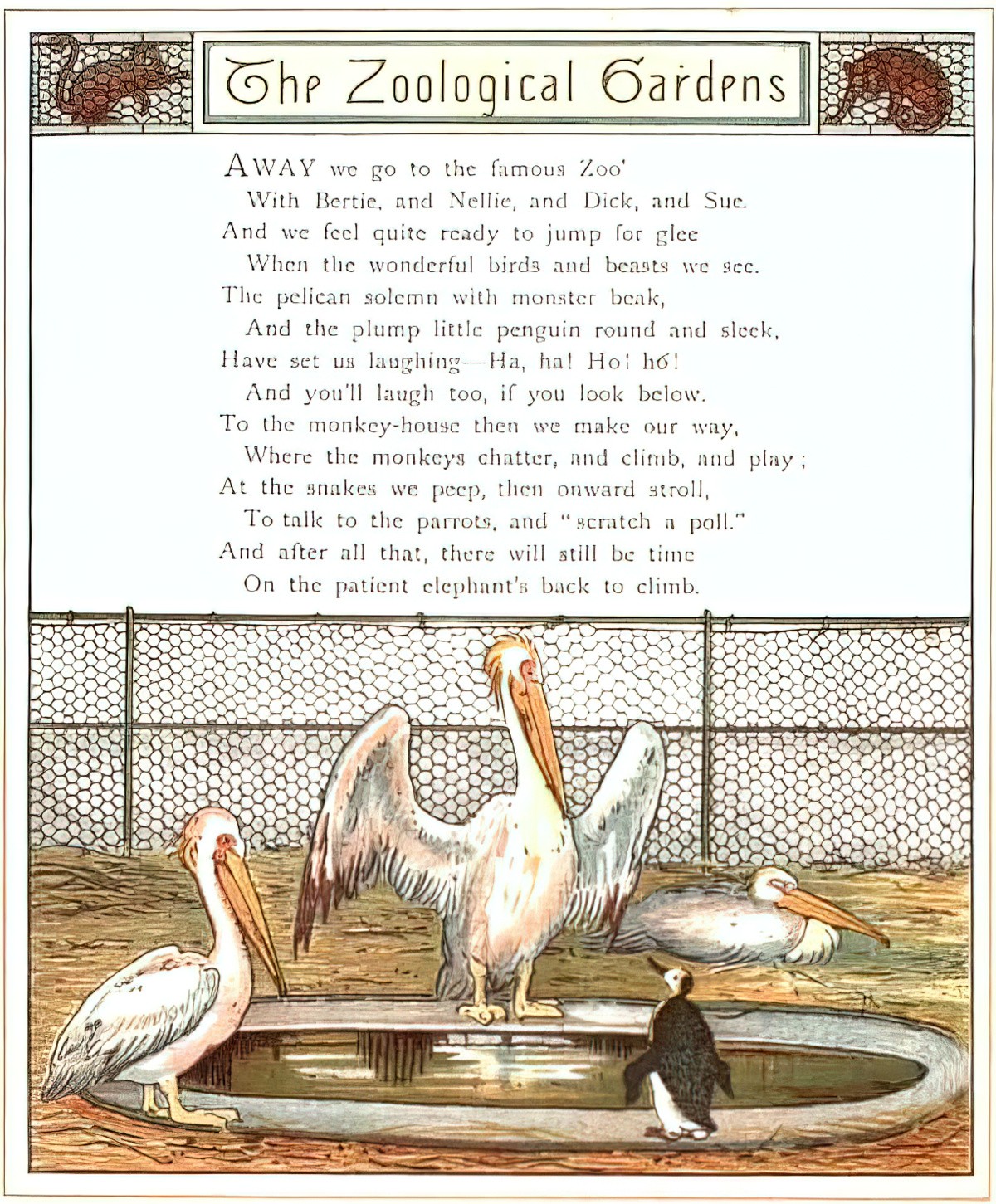
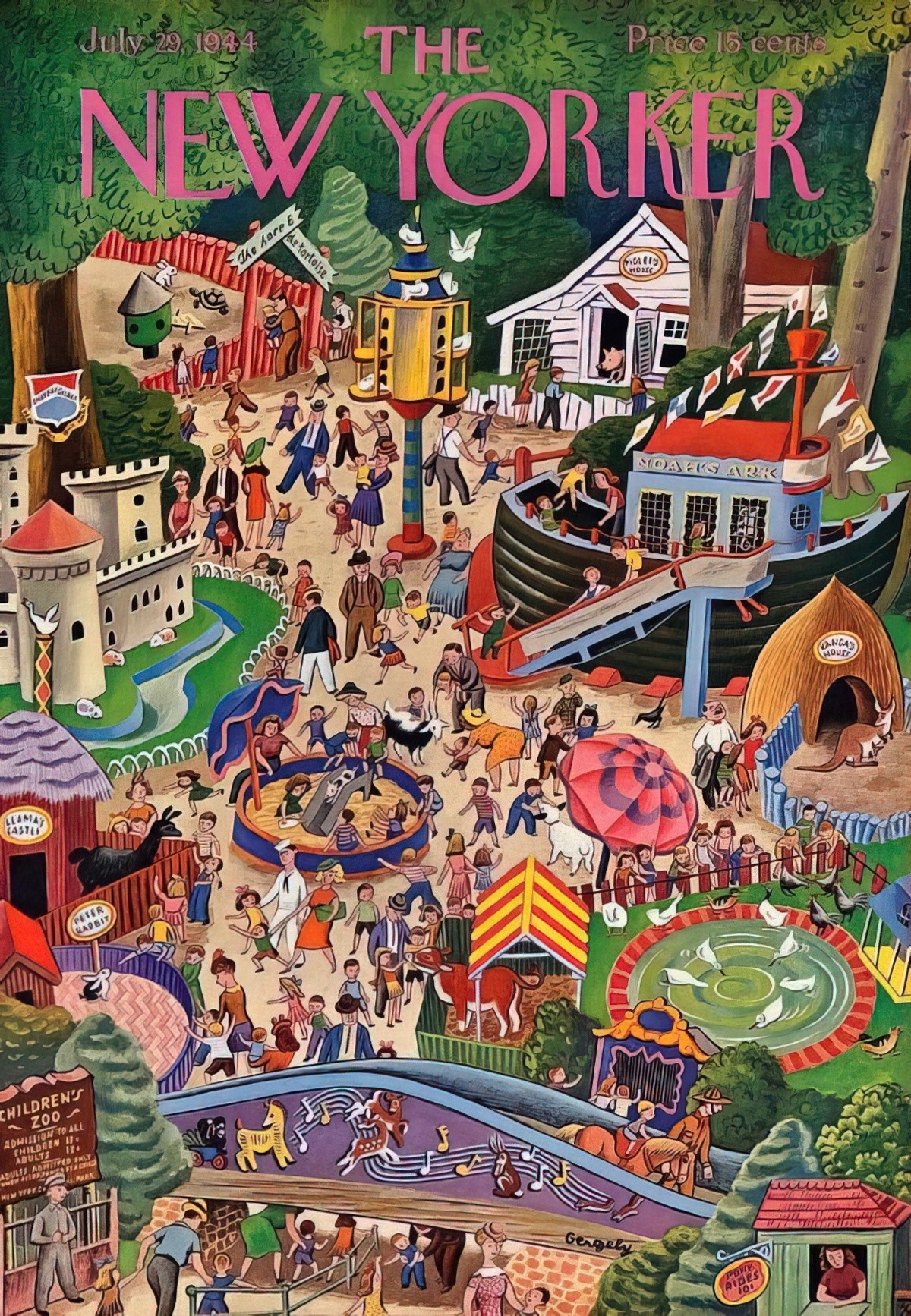
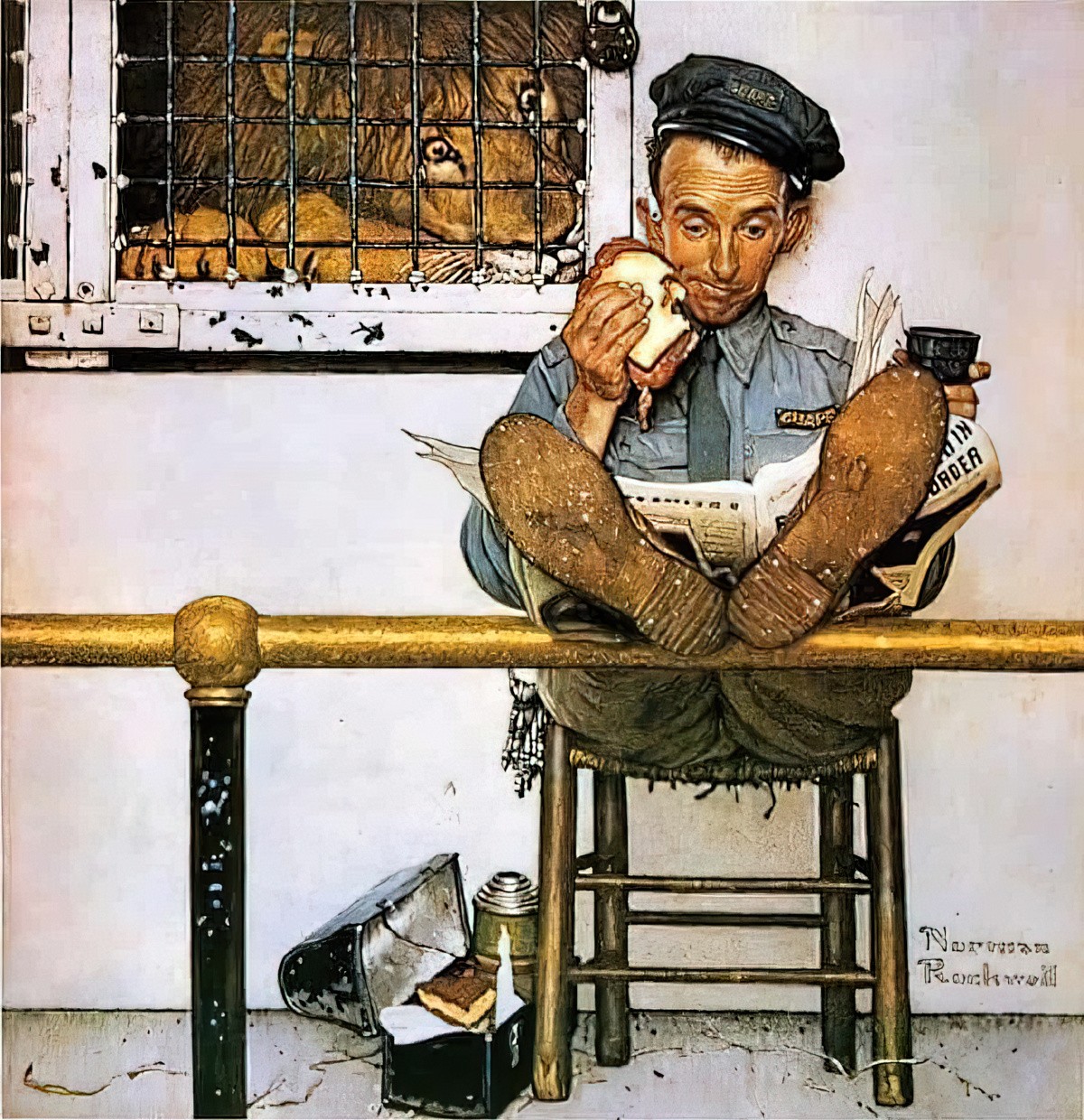
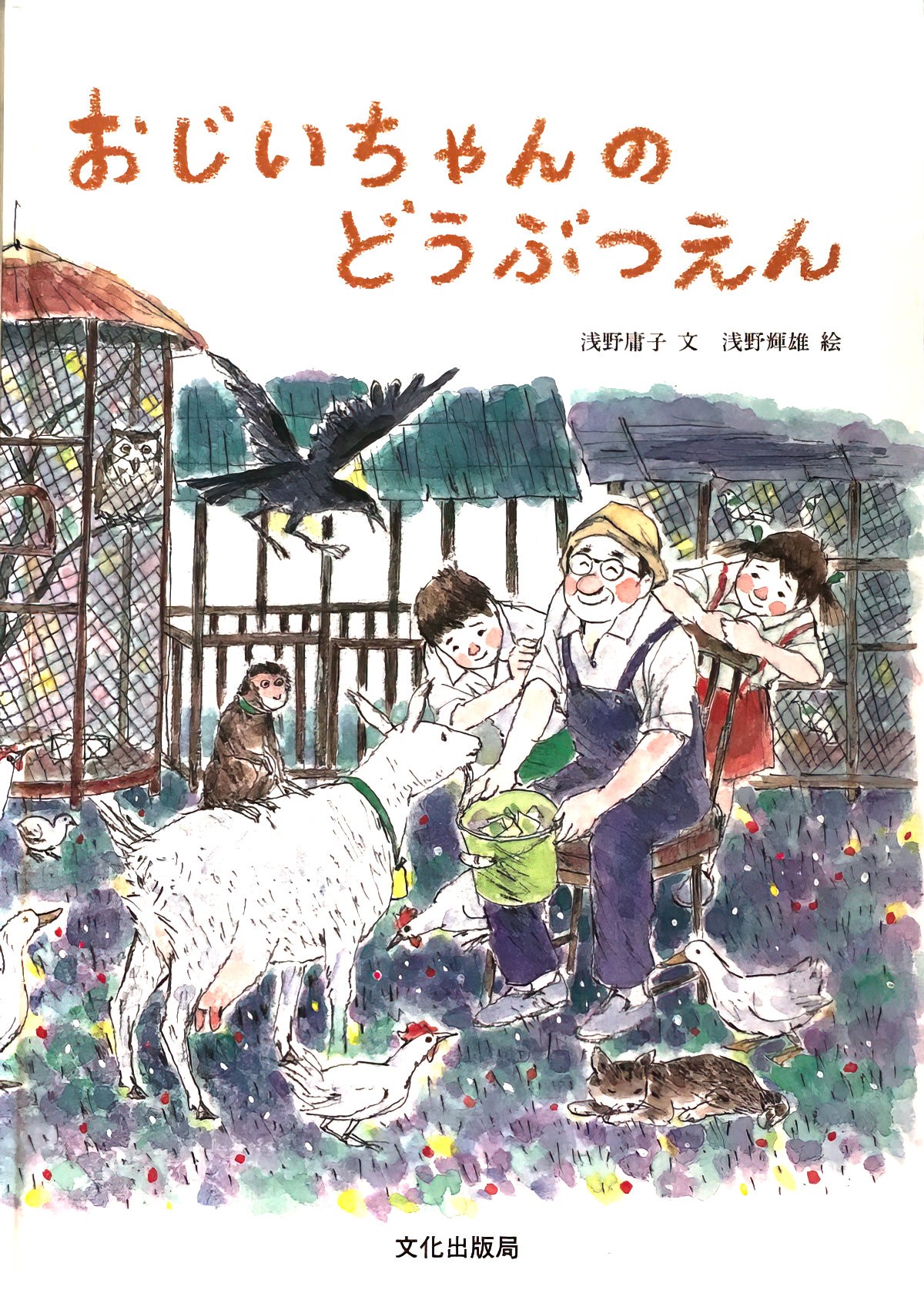
SETTING OF ZOO
- PERIOD — This picture book was published in 1992, a period in which traditional 20th century zoos were starting to reconsider their raison d’être. I’m of the generation who saw that change happen in real time. My early childhood experiences include visits to absolutely horrible zoos, which hadn’t quite gone by the time I was in my late teenage years. The most confronting zoo I visited was the Tokyo Zoo, in 1995 — a concrete establishment bereft of people. I went there with my fellow exchange student peers on a Sunday afternoon exploring central Tokyo and we left in a very dispirited mood. In my hometown of Christchurch, New Zealand, I remember seeing a gorilla locked inside a cage about the size of a bedroom. He had nothing to do in there except masturbate, which he did frequently, looking visitors right in the eye. I feel he knew exactly how confronting this was. And I can’t quite fathom how adults felt it was okay to exhibit that gorilla as a spectacle in the very same environment in which talk of masturbation, let alone the spectacle of it, was utterly taboo.
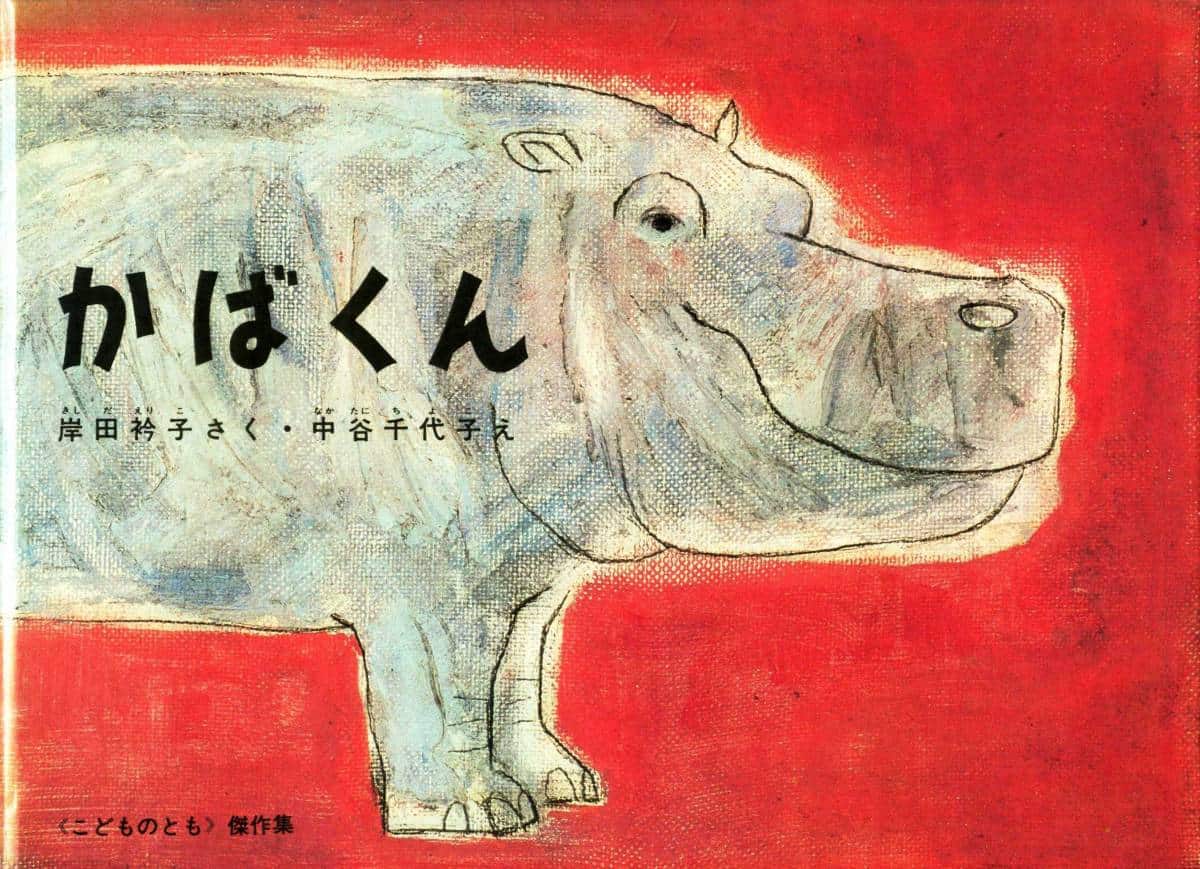
- DURATION — Anthony Browne’s Zoo takes place over part of a day. A day trip.
- LOCATION — This fictional zoo is positioned in the middle of a busy city. Browne is clear about that — the family gets stuck in a traffic jam in order to get to this artificial wilderness.
- ARENA —But even once inside the zoo, Browne’s backdrops offer us glimpses of the surrounding arena, which is completely devoid of greenery. Instead we see the least beautiful parts of humanity.
- MANMADE SPACES — I’m talking about the power pylons and the tall buildings, shown to us only in silhouette, making them seem even more ominous.
- NATURAL SETTINGS — The story has no natural setting at all, which is entirely the point. Although Browne’s critique of the zoo experience as Not Fun was new to picture books in 1992, there is a lengthy history of children’s storytellers subtley and not so subtley conveying the message that the country is wholesome and the city is dangerous for children, and that cities stifle childhood itself.
- WEATHER — If Browne wanted to create a genuine utopia he’d have created a blue sky with plenty of greenery, but in Zoo he does the opposite. The sky is as grey as they concrete zoo inside the concrete jungle of humanity.
- TECHNOLOGY CRUCIAL TO THIS PARTICULAR STORY — The zoo itself
- LEVEL OF CONFLICT — What’s going on in the wider world of the story, politically, socially, environmentally…? Politically, animal rights activists were starting to gain traction and the a greater proportion of the general public was starting to think a bit more critically about how we treat animals, especially wild animals, especially endangered species. I’m confident that zoos (and circuses) will one day be no longer a thing that exist. Most zoos in the year 2020 are doing a better job of creating the illusion of nature, and some perhaps genuinely provide a decent life for some of their animals. But there’s still a lot going on behind the scenes that would shock visitors. For instance, the giraffe at our local zoo is a main exhibit, and if you turn up for the talk you’ll hear all about what he eats, how he spends his days, and he’ll come close enough for you to admire his beautiful long lashes. Left out of the child-friendly talk: how a new giraffe was murdered one night in a territory fight, because giraffes are a violent, territorial species, and one zoo ain’t big enough for two males.
- THE EMOTIONAL LANDSCAPE — Here we are talking about the difference between what is real in the veridical world of the story and how a character perceives it — never exactly as it is, but rather influenced by their own preconceptions, biases, desires and personal histories. The characters in this particular story exist on a continuum between laughingly blasé (the father) and quiet, sober and concerned (the mother). The boy who narrates is noticing his parents’ reactions and, at the reflective time of retelling, seems to be making up his own about zoos. At this point he simply knows zoos are not fun. The details he tells us are centred on him, his own family and his own family’s experience of the zoo, not on the experience of the animals. The reader, however, with careful reading of the images, will see the exact ways in which this zoo is not fun: For the empathetic person, a zoo can’t be fun for humans if it’s not fun for animals.
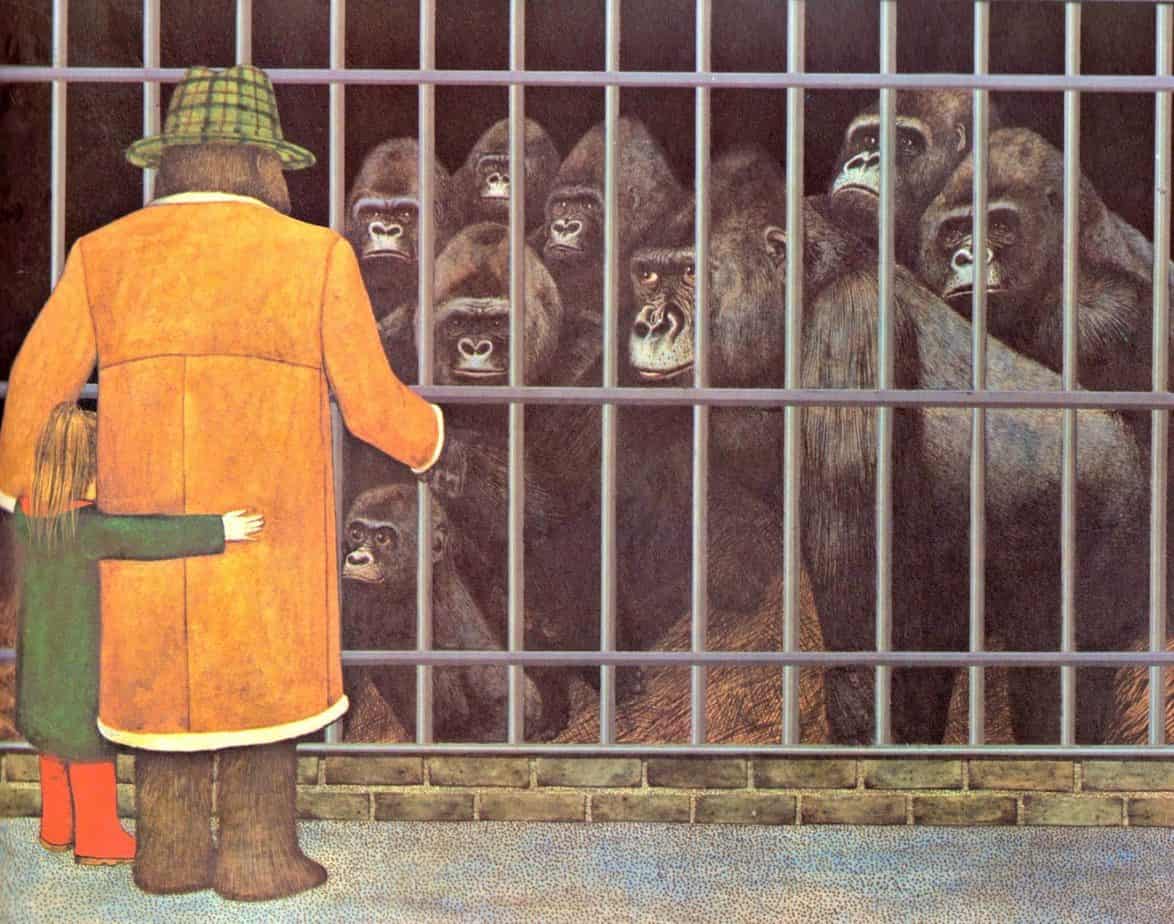
STORY STRUCTURE OF ZOO
PARATEXT
Unusually for Goodreads, the publishers have said nothing about this book other than:
Winner of the Kate Greenaway Medal.
The most upvoted consumer reviewers fall on a narrow spectrum between ‘I did not like this book’ and ‘I did not like this book but it’s important’.
SHORTCOMING
Zoo by Anthony Browne is an especially good case study in meaningful framing. Illustrators make various use of frames — doorways, windows and arches make for naturalistic architectural divisions of a scene. Frames can be created in other ways, too, for example in the opening image below. This looks like a simple page of portraits but on a re-read you’ll notice that those boxes separate each family member from each other, and the white space between them is the psychological distance between them. This is the story of a family separated from each other by metaphorical bars and white space.
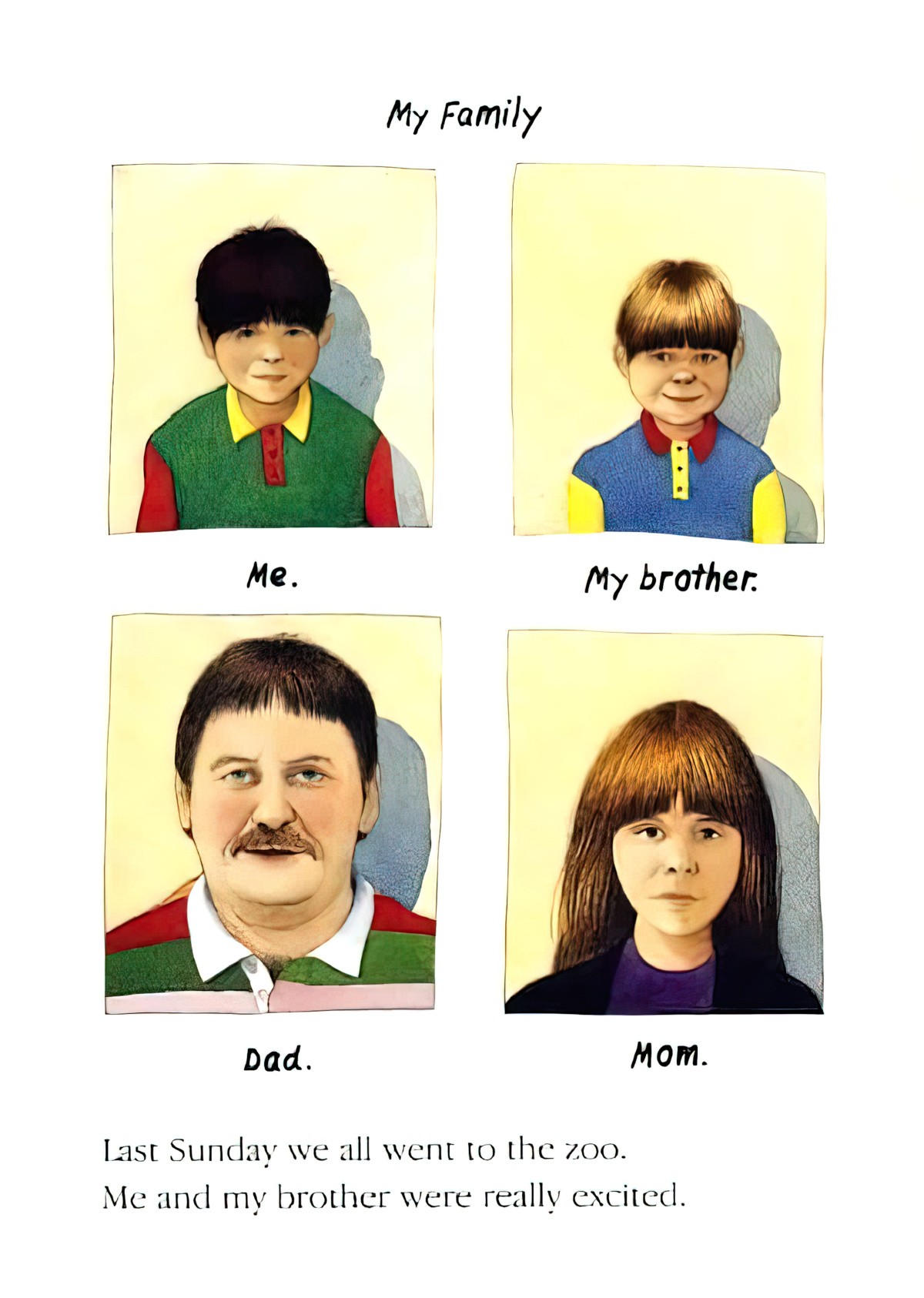
Stripes are another symbolic feature of the illustrations, most obviously in the stripy shirt worn by the father, the character most responsible for splitting the family apart.
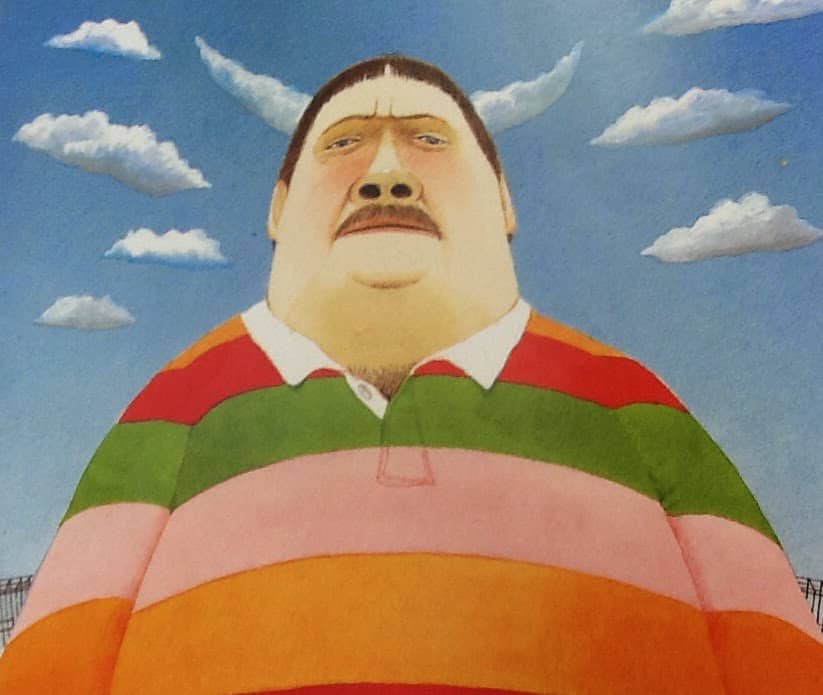
The mother doesn’t seem to have any power in this family. She does have a voice, though her observations don’t have any impact on her husband. This is an example of the well-established female maturity principle at work, in which female characters are the people in a story with extra insight, well-developed empathy. It is rare to find a gender inversion of this parental dynamic.
The boys might as well be zoo animals themselves because they are stuck in this family, forced to do whatever the adults require of them. At times they break out and rough and tumble with each other, much like monkeys.
DESIRE
The action is driven by the father, who is the only one in this family who thinks a trip to the zoo would be fun. We are shown this in the car, when the father is the only one to laugh at his own joke. Browne, in turn, makes this into a joke for the reader by saying ‘everyone laughed except’ (everyone else in the car). This solipsistic father has no empathy for the desires of the rest of his family.
However, Browne knows that children in children’s stories need their own desires in order for a story to work, so the boys do have wishes of their own: They want to see the monkeys and apes, not all the other ‘boring’ animals. When they do see the large ape, this will comprise the climax. (Subverted.)
OPPONENT
The parents have their own idea about how the day should pan out. It should be fun, dammit. Even though the boys are hungry, they are not allowed to eat until designated lunchtime. In this respect, the boys are like the animals, who must wait for their feeding time rather than hunting and eating according to their own rhythms.
Browne’s illustrations of the father emphasise his bulk, with worm’s eye views (rather, child-eye views) and in one disturbing picture he has his mouth wide open, similar to depictions of cannibalistic ogres.
The boys are depicted as monkeys. The father makes a joke about their monkey hats, and Browne has emphasised the boys’ faces to better resemble monkeys’ faces. In comparison to the gorilla, these small monkeys are helpless.
PLAN
The adults’ plan: To get value for money by visiting all of the animals. Browne shows us that the father doesn’t want to pay the entry fee because he lies about the son’s age to get a cheaper price. He also doesn’t pay for a map. (I deduce that’s why they don’t have one.) The family is therefore lost within the zoo, which is not at all like a wilderness but functions more like a labyrinth, in which the family are on this path and must walk around and around until allowing themselves a psychological out. No one has forced them into this labyrinth, but as in any mythological labyrinth, there will be a Minotaur at the centre, when the main character reaches the darkest depths of his soul.
THE BIG STRUGGLE/CLIMAX
So who is the Minotaur of this zoo-labyrinth? Is it the father? I believe it’s the father AND the gorilla, who is an absolutely pitiful creature. We don’t even see the gorilla’s face, just the hunched over, completely withdrawn, pathetic figure of a magnificent wild creature with beautiful reddish fur.
Anthony Browne uses the same illustrative trick in his retelling of Hansel and Gretel, in which the stepmother EQUALS the witch. Using illustrations, Browne melds a familiar (family) characater into the supernatural, mythical character, showing the reader that mythological creatures aren’t real, sure, but are even scarier than we thought; they walk among us. They live in our homes.
ANAGNORISIS
The boy narrator does not experience an “Oh my, zoos are horrible! I’m never visiting a zoo again!’ kind of epiphany. It would be unbelievable, and unlike a children’s story, if he did. Joycean epiphanies happen rarely in real life, and postmodern stories reflect that. This child’s naivety is established in the opening, when he uses ‘incorrect’ grammar ‘Me and my brother were really excited’. The introduction itself is naive, written in a ‘what I did on my holiday’ kind of way, as if required by his schoolteacher. One does not become all-seeing and wise over the course of a single outing.
Instead, the boy realises that zoos are not fun, which is just the first step towards full awareness of humans’ relationship to animals, and how far humans have become removed from our natural environments, of small communities, of ready access to nature, and everything that goes with that.
In a story like this this, the reader is supposed to have more of a revelation than the naive narrator. When developmentally reader to do so, the reader picks up the double meaning of the mother’s final observation:
“I don’t think the zoo really is for animals… I think it’s for people.”
First meaning: Zoos are no good for animals. They are good only for people.
Second meaning: Zoos are a type of cage for people, as well as for animals.
The illustration on the recto side of the spread encourages the second reading because now we see a close up of a gorilla not through bars, but through the archetypal storybook window frame, divided into four segments. This family is about to go home, and they talk about eating dinner, and what they will have. In a Magic Eye book kind of way, we can imagine seeing the family through that same frame, eating their burger and chips and beans — foods chosen by Browne specifically for being highly processed, removed from ‘nature’, not through the bars of a zoo, but through the equally restrictive ‘bars’ of a suburban window frame.
NEW SITUATION
That night I had a very strange dream.
Do you think animals have dreams?
The final sentence shows the reader that the boy narrator has finally started to think about the ‘humanity’ of the animals. He’s just starting to look outside the concerns of his own family.
The full-page recto imagery is a wide angle shot of a zoo in silhouette, but most of the page is sky and includes the moon. This functions as an outro shot seen frequently in film — big skies and oceans are commonly used to show the main character has achieved a wider view of the story situation. (Sometimes the storyteller elevates the main character by putting them on a hill or a roof.)
EXTRAPOLATED ENDING
This boy could go either way. He could side with his wholly unempathetic same-gender parent and become a big, strong man who laughs and cracks dad jokes and impresses his own thoughts and desires upon everyone around him, using his bulk like a wild male gorilla. Or he could forge a more modern path, using his mother as cue. The final sentence has suggested he’ll take the second path, but sometimes characters in stories have a temporary (“phantasmagoric”) epiphany then go right back to how they were before. (The Literary Impressionists were a fan of this kind of ending.)
RESONANCE
In the 19th century, families used to visit asylums for the insane as family outings. We now call this Asylum Tourism.
Modern families would shudder at asylum tourism, which is why I think future families will, in time, shudder at zoos (and circuses), if not already.
